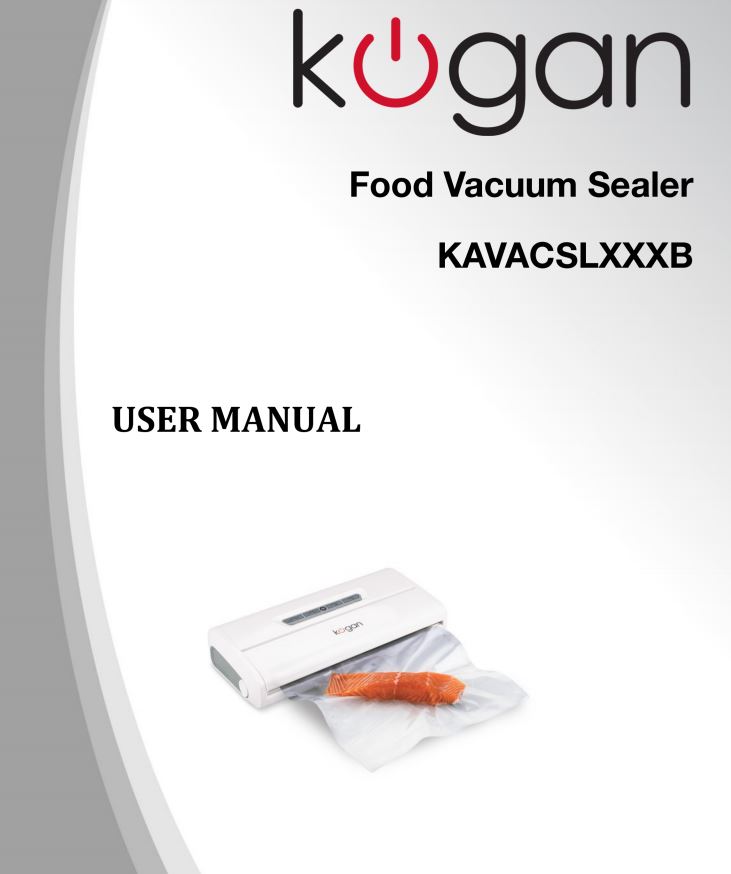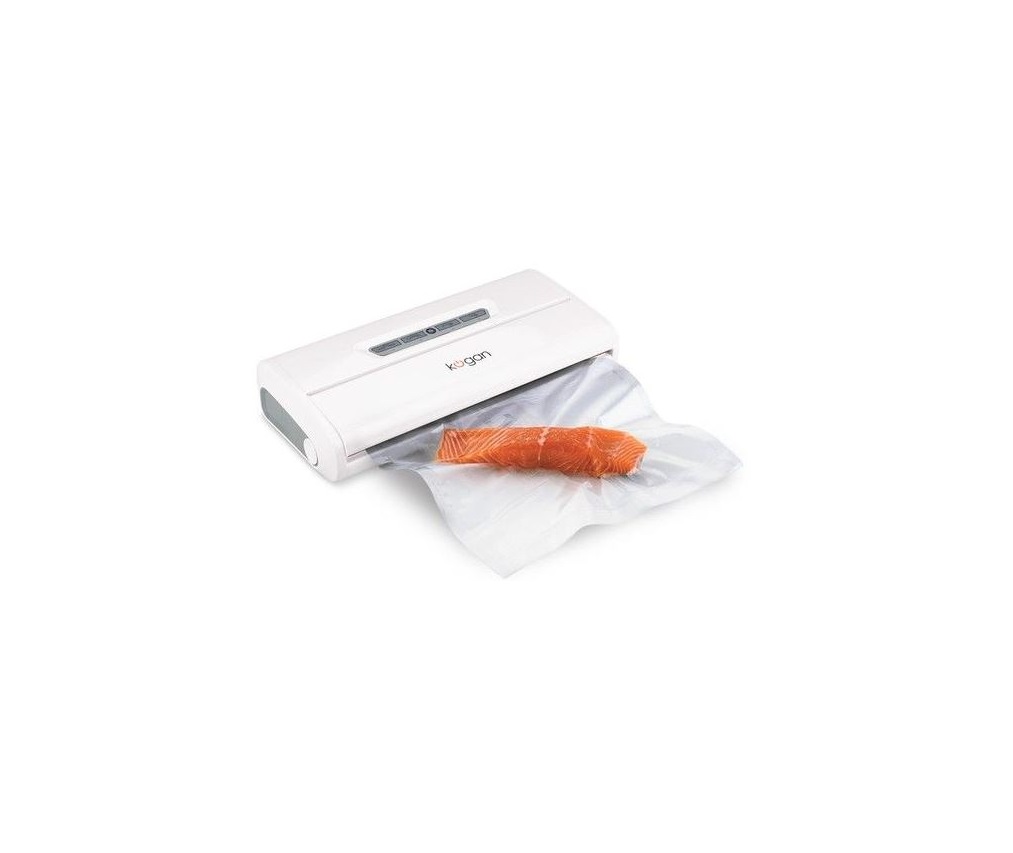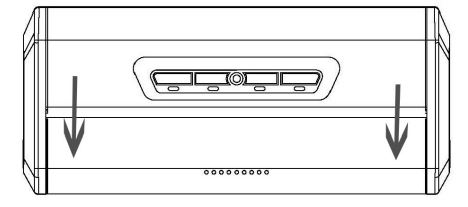Kogan Food Vacuum Sealer User Manual

Attention
Please handle this product with care and inspect it regularly to ensure it is in good working order.If the product, power supply cord or plug shows any signs of damage: stop use, unplug and contact Kogan.com support.
Safety Notices
Please read and understand all instructions and warnings prior to using this sealer. Your safety is paramount!
- Read all instructions carefully.
- Do not allow the sealer to be used as a toy or to be operated by children.
- Do not operate the sealer with a damaged power cord or plug.
- Do not use the appliance on a wet or hot surface, or near a radiant heat source.
- Always use the appliance on a level surface.
- Do not immerse any part of the sealer, power cord or plug into water or any other liquids.
- To disconnect, unplug the power cord from the electric outlet. Do not disconnect by pulling on the cord. Always unplug the sealer before cleaning and when unit is not being used.
- Do not operate the sealer if it malfunctions or is damaged in any way. If the cord or machine is damaged, please contact the Kogan customer support team for further information.
- The sealer is not designed for commercial use. If sealing more than 20 bags continuously, stop and wait at least 25 minutes before resuming use of the sealer.
- Keep the upper lid of the sealer unlocked when not in use.
This Appliance is for HOUSEHOLD use only.Do not attempt to service this product yourself. There are no user serviceable parts inside.
What’s in the Box
- Vacuum Sealer
- Starter Bags
- Quick Start Guide
Specifications
Dimensions — 340 x 150 x 64mmVoltage and Power — 220-240V ~ 50Hz 175WVacuum Degree — 0.6 ~ 0.8 bar
Product Layout
- A Vacuum Button: Press to vacuum package and seal food. Appliance shuts off automatically.
- B Cancel Button: Immediately halts the current function.
- C Pulse Button: Used when extreme control of the vacuum process is required for delicate foods. Press the button and the vacuum pumps activate. Release the button and they shut off.
- D Seal Button: 1) Press to create a seal when making bags from a bag roll. 2) Press to immediately stop the vacuum process and begin sealing the bag, preventing delicate foods from being crushed. 3) Press to create a seal on foil bags (such as a potato chip bag) to keep food sealed airtight.
- E Sealing Line: Do NOT remove the high-temperature resistant tape.
- F Accessory Port: Allows vacuum packaging with canisters and accessories.
- G Vacuum Chamber: Make sure to place the open end of the bag into the vacuum chamber for successful vacuuming.
- H Sealing Gaskets
Vacuum Sealing Guidelines
Food Storage & Safety
NOTE: Vacuum packaging is NOT a substitute for refrigeration or freezing. Any perishable foods that require refrigeration must still be refrigerated or frozen after vacuum packaging.
For best results in extending the life of foods, you should vacuum package foods that are fresh. Once food has begun to deteriorate, vacuum packaging will only slow the deterioration process. Vacuum sealing cannot prevent the growth of mold. Other disease causing micro-organisms can still grow in low oxygen environments.
Food Preparation Hints and Tips
Cooking, thawing and reheating Simmering food in a vacuum bag helps retain its flavor and helps with clean up as well, with no dirty pots and pans! When reheating foods in the microwave using the vacuum bags, always puncture the bag to allow hot air to escape. You can also reheat foods in the vacuum bags by placing them in water at a low simmer below 75°C.IMPORTANT: Always thaw foods in the refrigerator or microwave do not thaw perishable foods at room temperature.
Preparation Hints for Meat and Fish
Try pre-freezing meats and fish for 1-2 hours before vacuum packaging. This helps retain the juice and shape, and also provides for a better seal. If you can’t, place a folded paper towel between the food and the top of the bag, but below the seal area. Leave the paper bag in the bag to absorb excess moisture and juices during the vacuum packaging process.
Preparation Hints for Cheese
Vacuum package cheese after each use. If you make you bag a little longer than needed, you can reseal the same bag after each use.IMPORTANT: Due to the risk of anaerobic bacteria, soft cheeses should never be vacuum packaged.
Preparation Guidelines for Vegetables
Blanching is a process that should be done before vacuum packaging vegetables. This process stops the enzyme action that could lead to loss of flavor, color and texture. To blanch vegetables, place them in simmering water or in a microwave until they are cooked, but still crisp. Blanching times can range from 1 to 2 minutes for leafy greens and peas ; 3 to 4 minutes for snap peas, sliced zucchini or broccoli ; give your carrots about 5 minutes ; and 7 to 11 minutes for corn on the cob. After blanching, immerse vegetables in cold water to stop the cooking process.
Note: All vegetables (including broccoli, Brussels sprouts, cabbage, cauliflower, kale, turnips) naturally emit gases, during storage. Therefore, after blanching, it’s best if they’re stored in the freezer.
Vegetables are a great candidate for portion control ; when storing vegetables, try pre-freezing them for 1 to 2 hours, then separate them into meal portions within your vacuum bags. After they have been vacuum packaged, return them to the freezer.
IMPORTANT: Due to the risk of anaerobic bacteria, fresh mushrooms, onions & garlic should never be vacuum packaged.
Preparation Hints for Powdery Foods
When vacuum packaging powdery items like flour, it’s best to use their original packaging inside of the vacuum bags. The fine powder could get sucked into the machine and cause enough damage to shorten the life of the sealer.
Preparation Hints for Liquids
Before you vacuum package liquid such as soup stock, pre-freeze in a casserole dish, loaf pan or ice cube tray until solid. Remove frozen liquid from pan and vacuum package in the vacuum bags. You can then stack in the freezer. When you’re ready to use, just cut corner of bag and place in either a microwave dish or drop into water at a low simmer, below 75°C.
Product Usage
Making Custom Sized Bags
- Pull enough bag material to hold the item to be vacuumed, plus an extra 2 inches. With a pair of scissors or a sharp knife, cut the desired bag length from the bag roll. Make sure to cut in a straight line.
- Open the lid. Place one end of the cut bag onto the sealing strip. (Don’t worry if you accidentally place any material onto the gasket area.)
- Close the lid by pressing down on both sides. If the lid cannot be lifted, then you have successfully locked the lid into place.

- Now that the lid has been locked, press the “SEAL” button to create a custom sized bag. The indicator light illuminates during the sealing process.
- Once completed, the indicator light will turn off. Press the release buttons on both sides of the machine, then it is safe to take out the newly created bag.
- The custom sized back is now ready for vacuum sealing.
CAUTION: Make sure to give the sealer time to cool down. Wait at least 20 seconds between consecutive seals. Under heavy usage, the seal will shut down automatically to prevent over heating. If this occurs, please wait for 25 minutes to allow the sealer to cool down.
How to Vacuum Seal with Vacuum Bags
- Place the item(s) to be sealed into the pre-cut or custom sized bag. Leave at least 2 inches between the contents and the top of the bag to allow for bag contraction.
- Open the lid and place the open end of the bag down into the vacuum chamber.

- Close the lid by pressing down on both sides. If the lid cannot be lifted, then you have successfully locked the lid into place.
- To begin the vacuum process, press the “VACUUM” button. The unit will continue to vacuum and then seal once the air has been removed.
- Once the indicator light has turned off, press the release buttons on both sides of the machine to release the bag.
Since the pressure under the normal vacuum function is set to be high, sometimes it is easy to destroy some delicate items by high pressure in the vacuum bags. In this case, you can use the ”PULSE” vacuum function to control the vacuum time and pressure, and prevent crushing delicate items. When packing some juicy foods, you can also use this function and prevent liquid being sucked out.
- Place the item(s) to be sealed into the pre-cut or custom sized bag. Leave at least 2 inches between the contents and the top of the bag to allow for bag contraction.
- Open lid and place the open end of the bag down into the vacuum chamber.
- Close lid by pressing down on both sides. If the lid cannot be lifted, then you have successfully locked the lid in place.
- Press the ”PULSE” button continually until it reaches the pressure that you want. You can watch the vacuum bag to decide the pressure. During this process, you can stop the vacuum by releasing the button; then press it again to start the vacuum again.
- When the pressure reaches the desired level, press ”SEAL” button to start sealing.
- Once the indicator light has turned off, press the release buttons on both sides of the machine to release the bag.
Care, Cleaning & Maintenance
- Always unplug the sealer before cleaning.
- Do not immerse in water.
- Do not use abrasives or chemicals to clean the unit.
- Wipe the outer surface with a soft, damp cloth and soap.
- To clean the inside of the unit, wipe away any food or liquids with a paper towel.
- Dry all parts thoroughly before you plug the unit in and operate it again.
- The vacuum chamber may trap some liquids that are drawn from the bag. Use a mild dish washing soap and a warm, damp cloth to wipe away any liquid left in the vacuum chamber. Dry thoroughly.
Troubleshooting
- Make sure the power cord is correctly plugged into the electrical outlet.
- Make sure the power cord is not damaged in any way.
- Make sure the electrical outlet is operative by plugging in another appliance. If it’s not, please check the circuit breakers or fuses in your home.
- Make sure the bag is positioned correctly down in the vacuum chamber.
- Press down on both sides of the lid and make sure it is locked in place.
- Wait 25 minutes to allow appliance to cool off, and then try using again.
Air is not being vacuumed out of the bag
- Check that there are no gaps, folds, wrinkles or holes in the pre-sealed bags.
- Check for loose, worn or cracked Upper and Lower sealing gaskets.
- Foods with high liquid contents may prevent the bag from sealing properly. Cut the bag open and wipe the top inside of bag, then reseal.
- Check to see if bag is properly inserted into the vacuum chamber.
- Make sure you’ve placed the bag in the proper place. When making a bag from a roll, make sure end of cut piece is on the sealing strip.
The bag is melting
- The sealing strip may have been too hot during the sealing process. Allow the unit to cool for 20 seconds between uses. If the bag continues to melt, allow unit to cool with the lid in the upright position for 25 minutes before using.
Air has seeped back into the bag
- Check the seal of the bag. There may be a hole or wrinkle that is allowing air to reenter the bag. Carefully cut the bag open and re-seal it, or use an entirely new bag.
- Make sure there is no moisture or liquid from the food present within the bag seal. You may need to cut open the bag and re-seal it, or use an entirely new bag. Partially freeze foods with excess liquids, prior to vacuum sealing.
- Make sure there are no food items with sharp edges that may have punctured the bag. If you find a puncture hole, seal the item in an entirely new bag.
- Make sure no liquids were drawn to the sealing strip area.
- Check for loose, worn or cracked Upper and Lower sealing gaskets.
- Moisture of foods with high liquid content will prevent the bag from sealing properly. Cut bag open and wipe the top inside of bag, then reseal.
Bag will not seal
- Check that there aren’t any gaps, folds, wrinkles or holes in pre-sealed edges.
- Moisture of foods with high liquid content will prevent the bag from sealing properly. Cut bag open and wipe the top inside of bag, then reseal.
- Make sure you’ve placed the bag in the proper place. When making a bag from a roll, make sure end of cut piece is on the sealing strip.
- Make sure you’ve given the appliance time to cool down. Wait 20 seconds between seals
If you have any questions, please contact the Kogan customer support team.
[xyz-ips snippet=”download-snippet”]



